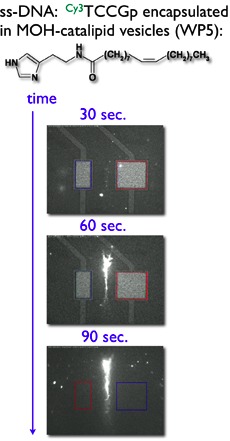The electronic control of chemistry in multiphase systems has not yet been fully addressed. An example of what has been achieved in this direction is indicated in the opposite fluorescence video sequence where the electrodes of the Chemical Microprocessor induce a combination of lipid structure concentration and phase shifts.
These first pre-experiments regarding electronic controlled enrichment of "loaded" vesicles were performed using catalipid based Giant Unilamellar vesicles (synthesized in WP5), filled with fluorescent-labeled ss-DNA (Cy3-TTCCGp). The lower series fluorescence images at different times illustrate concentration of vesicle control, via appropriate electrode cycling, we can reproducible concentrate lipid structures between two active microelectrodes.
The experiments implies that it should be possible in future to also control chemistry happening in such structures, through appropriate electronic control of concentrations of substances in the buffer medium and of the structures themselves as well as evolutionary optimization of vesicles.






